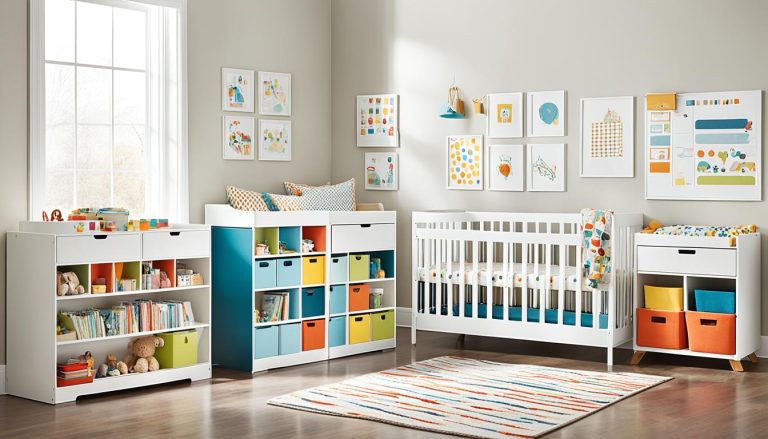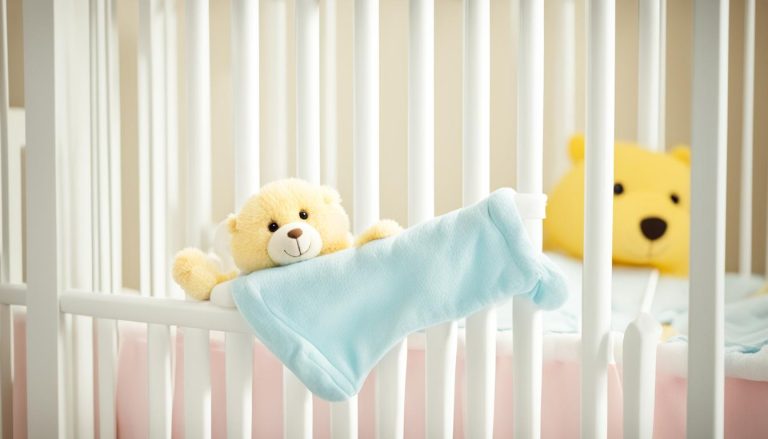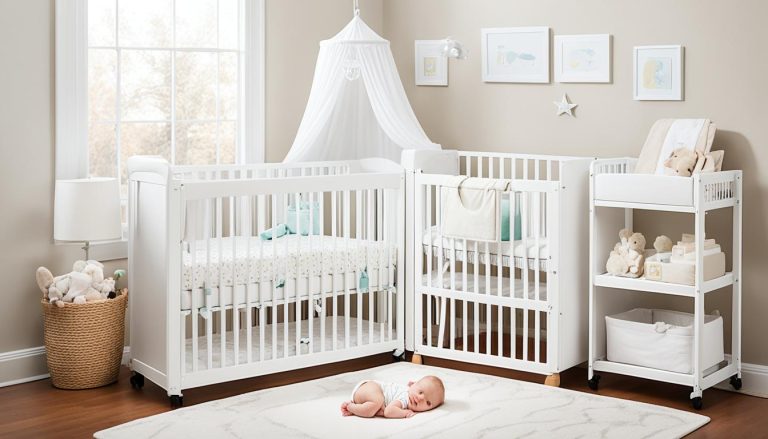Montessori Principles in Your Nursery Design: Creating a Child-Centered Environment
houseremodelingnews.com may earn a commission if you purchase a product through one of our links
“The child is both a hope and a promise for mankind.” – Maria Montessori
Picture a nursery where your little one can grow, learn, and be independent. That’s what a Montessori-inspired space offers. By using Montessori ideas in your nursery, you create a place that encourages curiosity and self-reliance.
The first six years of a child’s life are key for growth. Dr. Maria Montessori’s work shows this. Her method focuses on learning that fits each child’s needs and interests. In fact, 94% of parents saw their kids become more independent with Montessori at home.
Creating a Montessori nursery is more than making it look good. It’s about making a space where your baby can explore safely and freely. With low furniture and easy-to-reach toys, every part of the room helps your child grow. Are you ready to turn your nursery into a place of learning and discovery? Let’s start!
Understanding the Montessori Approach to Nursery Design
Montessori education has a special way of designing nurseries. It focuses on the child, making spaces that help them grow independent and learn by exploring. Let’s look at the main parts of Montessori nurseries and how they help your child grow.
Key Principles of Montessori Education
Montessori nurseries are all about giving children a space to explore freely. They focus on order and simplicity, choosing a few quality items over many toys. This way, each child gets a space that fits their needs and interests at their stage of development.
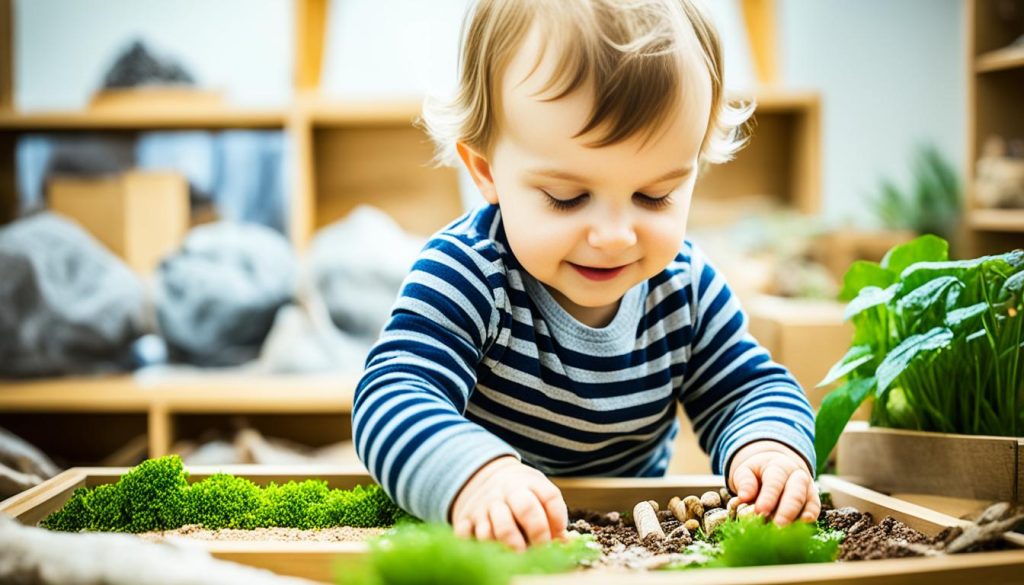
Benefits of a Montessori-Inspired Nursery
Montessori nurseries are great for your child’s growth:
- Promotes independence and decision-making skills
- Encourages sensory learning and exploration
- Supports physical and cognitive development
- Fosters autonomy in daily activities
- Stimulates language development through age-appropriate materials
The Importance of a Prepared Environment
The prepared environment is key in Montessori education. In a Montessori nursery, it means making a safe, engaging space for your baby. Important parts include:
- Child-sized furniture for easy access and use
- Low shelves with toys right for your baby’s age
- Natural materials that engage the senses
- Distinct areas for sleeping, feeding, movement, and care
By following these ideas, you make a caring space that helps your child grow and be independent from the start.
Creating a Safe and Accessible Space
Safety is the top priority in a Montessori nursery. Make sure your baby’s room is easy to baby-proof. It should have no sharp edges or loose electrical outlets. Good air flow and lots of sunlight are also important for a healthy space.
Think about your child’s view when designing their nursery. Put toys and furniture within their reach. This lets your baby explore on their own, which is key in Montessori education.
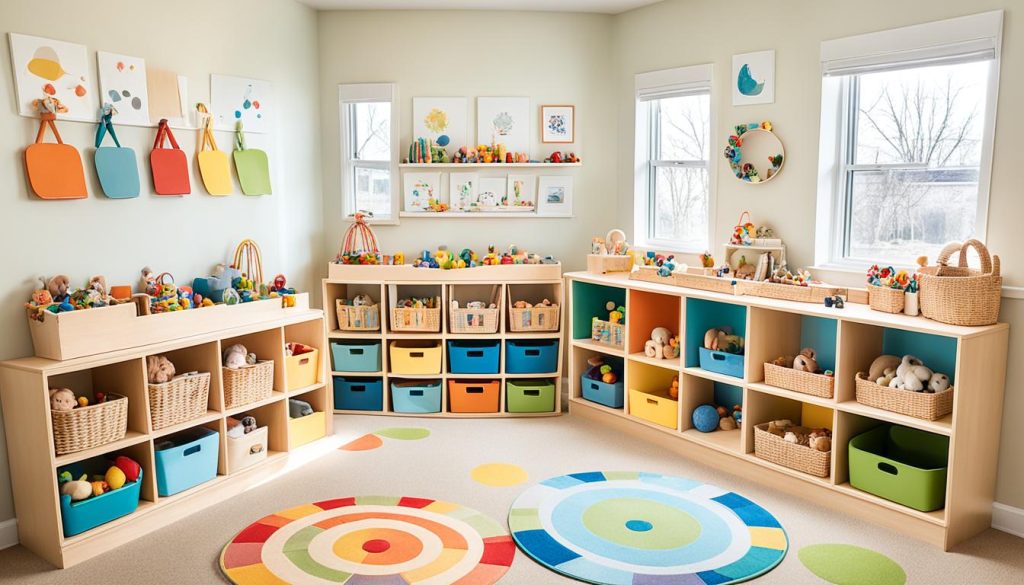
Being safe isn’t just about removing dangers. It’s also about making a space that helps your child grow and learn. Here are some ideas for a Montessori-inspired nursery:
- Low shelves for easy access to toys
- Soft play areas for safe exploration
- Child-sized furniture to promote independence
- Natural materials to stimulate senses
An accessible nursery design is more than just what’s in the room. It’s also about how the room is set up. Keep it tidy and simple. This helps your baby focus and learn better without feeling overwhelmed.
“The environment must be rich in motives which lend interest to activity and invite the child to conduct his own experiences.” – Maria Montessori
By focusing on safety and accessibility, you’re helping your child grow and develop. A safe, easy-to-get-around nursery lets your little one explore, learn, and do well in their own space.
Incorporating Natural Materials and Textures
Natural materials are key in making a nature-inspired nursery. Wood, cotton, and other organic elements add warmth and texture. They also offer rich sensory experiences that help your child grow.
Choosing Natural Elements
Go for wooden toys, cotton bedding, and wool rugs for a cozy feel. These materials are safe, long-lasting, and good for the planet. They give your baby different textures to touch, which helps with thinking and moving skills.
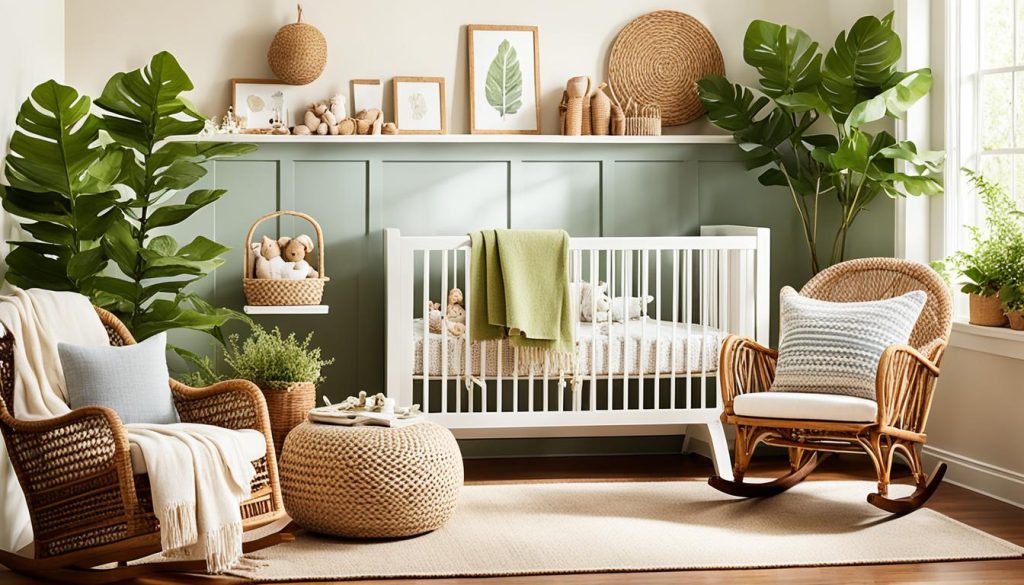
Sensory Exploration and Child Development
Sensory exploration is important for your baby’s growth. Natural materials have various textures, colors, and smells that catch your child’s attention. This helps their brain develop and makes them curious about the world.
- Wood: Smooth, grainy textures
- Cotton: Soft, breathable fabric
- Stone: Cool, varied surfaces
- Glass: Smooth, reflective qualities
Nature-Inspired Decor
Bring nature inside with decor inspired by the outdoors. Add plants to clean the air and make the space calm. Pick artwork with natural scenes or animals to inspire your baby’s imagination. These things help your baby feel connected to nature and make the nursery peaceful.
“Nature is the best teacher for a child’s developing mind.”
Using natural materials and textures makes a rich sensory space. It supports your baby’s growth and helps them love nature.
Designing for Independence and Autonomy
A Montessori nursery layout encourages child independence and self-learning. It’s about making a space that lets young ones grow and rely on themselves. The goal is to design a place where kids can learn and grow at their own speed.
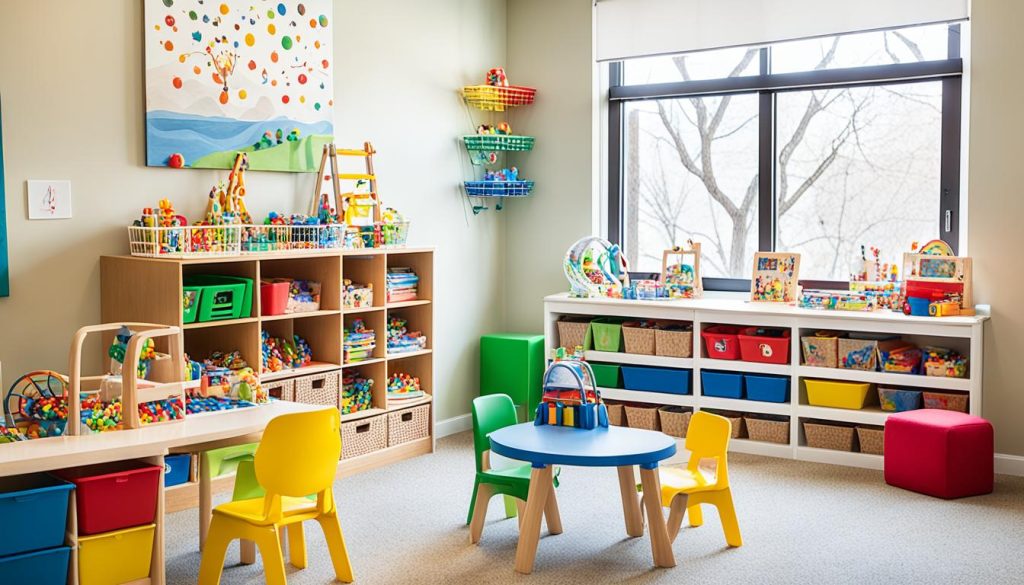
In a Montessori nursery, low shelves and easy-to-reach storage are key. They let kids get toys and books by themselves, helping them make choices and learn on their own. Choosing toys and materials that fit their age lets them learn through hands-on activities.
Think about adding self-care spots in your nursery. This could be a small mirror with a brush or a spot for putting on shoes. These areas help kids learn to do things by themselves and build practical skills. The aim is to make your child feel strong and sure of themselves.
A well-designed Montessori nursery fosters independence, decision-making skills, and boosts confidence in children.
When picking furniture, go for pieces that are the right size for kids. Low tables and chairs let kids do activities without needing help. This shows respect for their need to be independent and helps with their growth.
- Use neutral colors to create a calm environment
- Incorporate soft, non-slip rugs for safe movement
- Select decor made from non-toxic materials
- Ensure all items are securely fastened for safety
With careful planning, your nursery can be a place that helps your child grow independent and supports their learning and self-discovery.
Selecting Age-Appropriate Furniture
Choosing the right furniture is crucial for a Montessori-inspired nursery. It helps your child become independent and curious while keeping them safe and comfortable.
Low Shelving and Open Storage Solutions
Low shelves are a must in Montessori furniture. They let kids get toys and materials on their own. Open storage helps with organizing and lets kids see what they have. Pick pieces that are light and can move as your child grows.
Child-Sized Tables and Chairs
Child-sized furniture is vital in a Montessori nursery. Small tables and chairs make sure kids can sit comfortably and do activities at their level. This helps with posture and focus. Choose furniture made from natural materials like wood for durability and a nice touch.
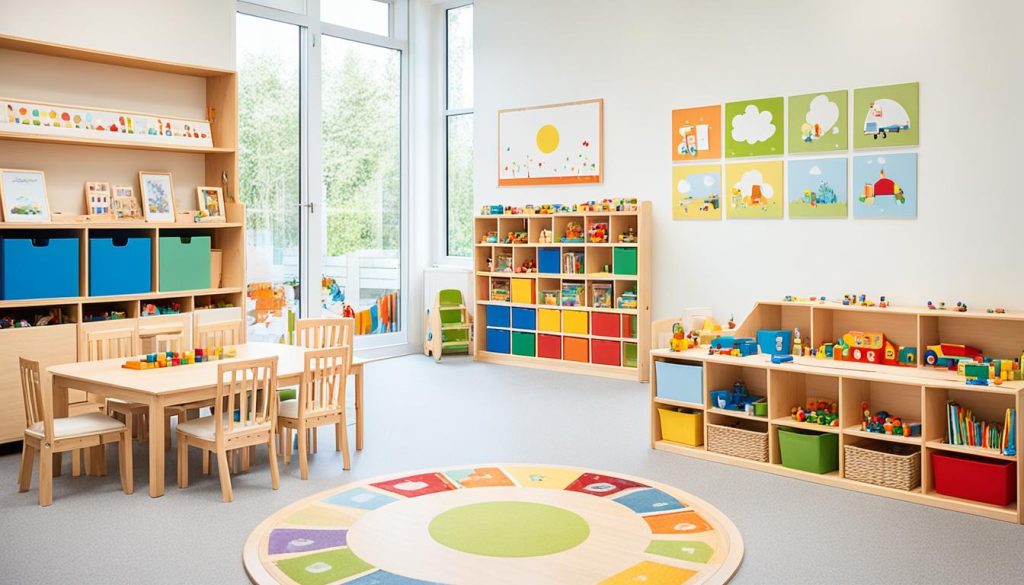
The Montessori Floor Bed Concept
A montessori floor bed is a special part of these nurseries. It’s just a mattress on the floor or a low frame. This setup helps your child get in and out of bed safely, teaching them to be independent early. It also lets them explore their room, which is good for their curiosity.
“The child’s development follows a path of successive stages of independence, and our knowledge of this must guide us in our behavior towards him.” – Maria Montessori
The secret to picking good Montessori furniture is to keep things simple, easy to reach, and focused on the child. This helps your little one grow and learn in a caring environment.
Incorporating Montessori Principles into Your Nursery Design

Creating a Montessori-inspired nursery helps your child grow independent and curious. The American Montessori Society has over 10,000 members. They stress the need for a well-prepared environment in early learning. By using montessori design ideas, you make a nursery that helps your baby grow from the start.
Begin by making the space tidy and simple. Montessori nurseries have just a few toys, placed on low shelves. This lets your child focus on play without feeling overwhelmed. Choose toys that encourage thinking and using senses, like wooden and fabric ones.
Add practical life activities to your nursery. Create a spot for your child to use small cleaning tools or prepare simple meals. These activities improve hand skills and make your child feel independent. Montessori believed in learning by doing.
- Use a neutral color palette to create a calm atmosphere
- Maximize natural light to enhance the learning environment
- Include live plants or a small fish tank to connect with nature
- Consider a floor bed instead of a traditional crib for safe exploration
By carefully applying these montessori design ideas, you make a nursery that supports your baby’s growth. This caring space lays the groundwork for a life full of learning and independence.
Organizing Toys and Learning Materials
In a Montessori nursery, how you organize toys is key to a great learning space. You should have a few, well-chosen montessori learning materials on open shelves. This lets your child easily get to toys and helps them make choices and be independent.
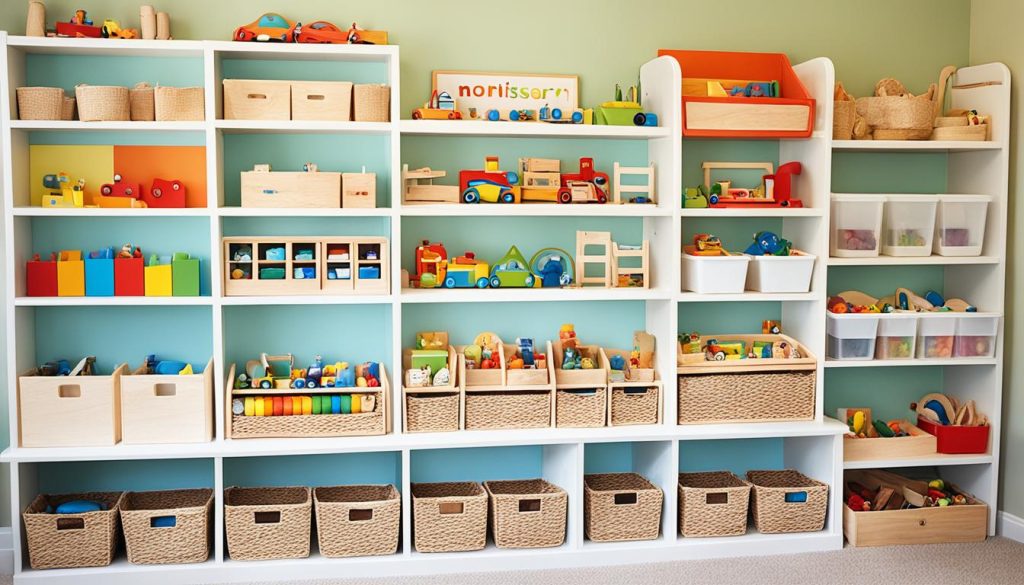
Studies show that having fewer toys is better. A study found toddlers played more deeply with four toys than with 16. Try changing toys every one to three weeks to keep things interesting for your child.
Here are some tips for arranging montessori learning materials:
- Use child-sized shelves (16-32 inches tall for infants and toddlers)
- Organize toys from left to right, increasing in difficulty
- Include a variety of toys to foster different skills
- Use baskets for small items to maintain organization
The aim of organizing toys in a Montessori nursery is to make a space that encourages exploring, solving problems, and experiencing the senses. By choosing and arranging materials carefully, you help your child learn and grow on their own.
The Importance of Minimalism and Uncluttered Spaces
Creating a minimalist nursery helps make a calm and focused space for your child. By decluttering, you can make a space that encourages learning and independence.
Decluttering Strategies for a Montessori Nursery
Begin with neutral colors like white, beige, or gray for a calm feel. Choose furniture that is quality, durable, and has clean lines. For instance, go for cribs with built-in storage or changing tables that also serve as dressers.

Open shelving is great for showing items while looking modern. It follows Montessori ideas by letting kids easily get to their things. This helps them be more independent.
Rotating Toys and Materials to Maintain Interest
Use a toy rotation system to keep your child interested and avoid too much clutter. This keeps the space focused and cuts down on feeling overwhelmed. Choose sustainable items like organic cotton toys or wooden puzzles to fit your minimalist style.
Creating Designated Activity Areas
Organize your nursery into different Montessori activity areas. Make a reading nook with a low, sturdy shelf for books. Set up an art space with things like natural objects and art supplies. These areas help with creativity, solving problems, and being independent.
A clutter-free and flexible nursery makes it easy to change as your child grows. By choosing minimalism, you’re making a space that helps your child grow. It also means you won’t need to redo the nursery often.
Integrating Movement and Gross Motor Development
A Montessori nursery should focus on physical activity. A movement area helps kids grow their gross motor skills and boosts montessori physical development. Adding things that encourage movement helps your child explore and grow naturally.
Use a soft floor mat for crawling and rolling. It’s a safe place for your child to practice basic movements. Add a low bar for pulling up to stand, helping your child move around. Leave open floor space for walking and running as they get better.
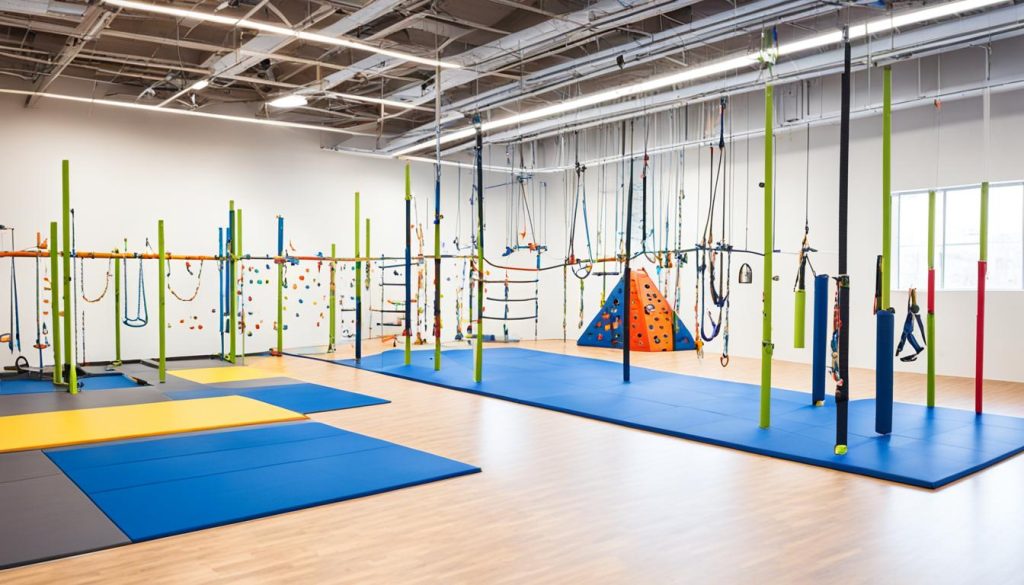
Think about adding a Pikler triangle or a small climbing wall. These things offer challenges that improve gross motor skills safely. They let your child climb, balance, and get stronger.
“Movement helps the development of the mind.” – Maria Montessori
The aim is to make a space that encourages exploring and being active. By adding movement to your nursery, you’re helping your child develop physically and love learning through activity.
Fostering Creativity and Imagination
Montessori nurseries are perfect for sparking your child’s imagination. They are designed for open-ended play and artistic expression. With some planning, your child’s room can become a creative space.
Open-ended Toys and Materials
Choose toys that can be used in many ways. Blocks, scarves, and natural items like pinecones or shells are great. They help your child invent games and solve problems, boosting their creativity.
Art Spaces and Creative Corners
Make a special art corner in your Montessori nursery. Have a low table with crayons, paper, and scissors that kids can easily reach. This makes art easy and fun for them.
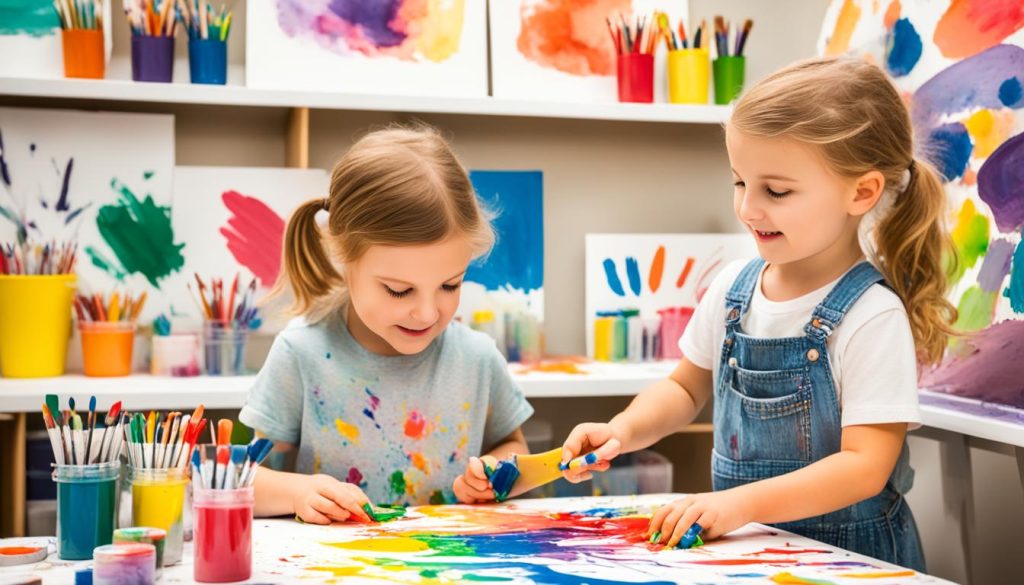
Encouraging Pretend Play
Montessori doesn’t focus much on structured pretend play. But, you can still encourage your child’s imagination. Use simple props like play silks or wooden utensils that can be anything in their mind. Real items like small brooms or watering cans also help with pretend play and real-life skills.
Creating a space for open-ended play and art is key to your child’s creativity. In a Montessori nursery, a few well-chosen items can lead to endless imagination. It’s all about giving your child the freedom to explore and create.
Implementing Practical Life Skills in the Nursery
Montessori practical life activities are key in a child-centered nursery. They help kids become independent, focus better, and improve their hand skills. By using self-care skills and tools made for kids, your little one can grow and thrive.
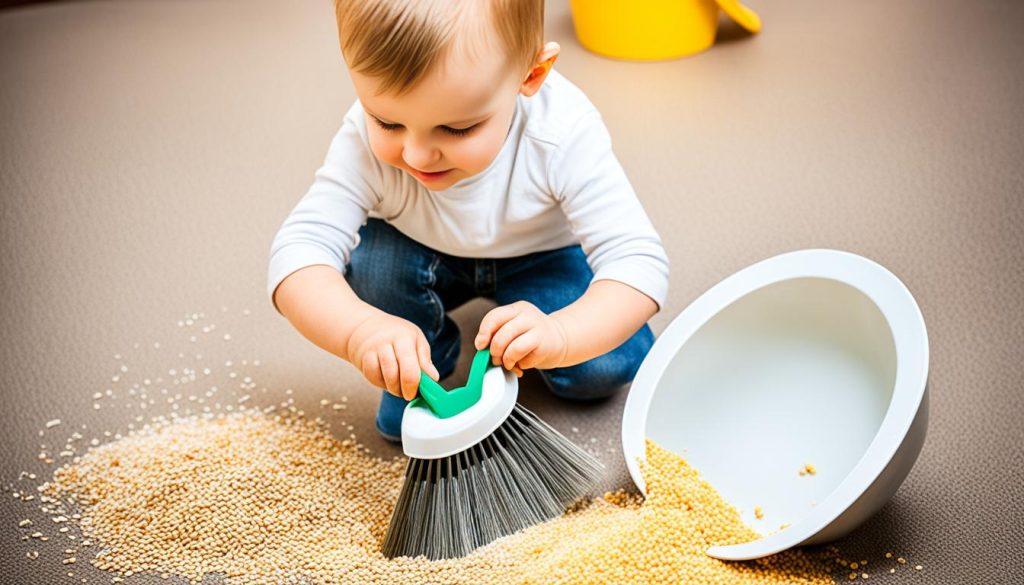
Begin with a small cleaning station that has child-sized brooms and dustpans. This lets your child help keep their space clean. Near a dressing area, put a low mirror to help with self-care like buttoning and zipping.
Set up a food prep area with tools that are safe and the right size for kids. This can include:
- Small cutting boards
- Plastic knives for slicing soft fruits
- Measuring cups for pouring activities
These practical life activities teach kids to feel proud of their work and solve problems. They gain confidence by doing things on their own.
“Practical life activities show children that seemingly mundane tasks hold inherent dignity.”
Keep changing activities to keep things interesting. As your child gets older, make the tasks more challenging. This way, they learn important life skills at their own speed, just like Montessori teaches.
Creating a Cozy Reading Nook
A well-designed Montessori reading area is key to helping young children love reading. It should be inviting with books that are right for their age. This encourages a love for reading from a young age.
Begin by setting up low, easy-to-reach bookshelves or baskets. This lets kids pick their own books, teaching them to make choices and think for themselves. Change the books often to keep things interesting and introduce new topics.
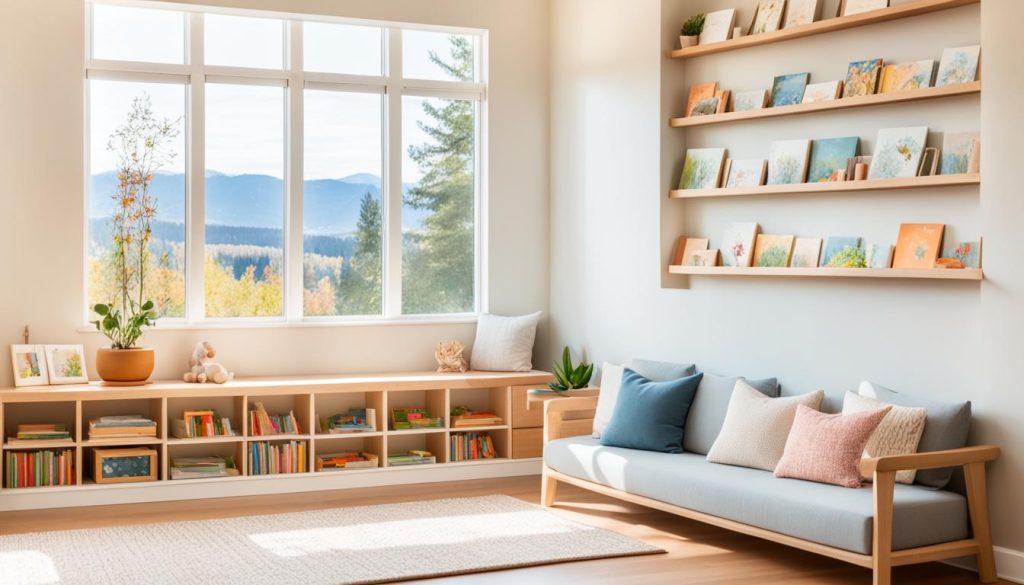
Comfort is important in a reading nook. Add soft floor cushions or a small armchair for kids to relax in while they read. This makes reading a cozy and enjoyable experience, helping them spend more time with books.
Have both fiction and non-fiction books in your collection. This mix helps with different literacy skills, like learning new words and thinking critically. Choose books that match your child’s interests and reading level.
“A child who reads will be an adult who thinks.” – Unknown
With these elements in your Montessori reading area, you’re creating a space that fosters a lifelong love for reading. It also supports your child’s literacy development journey.
Final Thoughts
Creating a Montessori-inspired nursery is great for your child’s growth. It helps them become independent and love learning. This approach has been around for 100 years and works well for kids in many areas.
You don’t have to change everything to use Montessori at home. Start with simple steps like using natural materials and setting up low shelves. These changes help your child learn on their own and be more independent.
Some people might not like Montessori, but many parents and teachers see its value. Jeff Bezos has even donated $1 billion to Montessori schools. By using Montessori ideas in your nursery, you’re helping your child be creative and curious for life.

